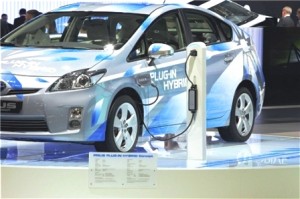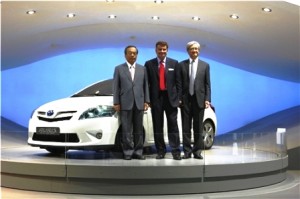Toyota Motor Corporation (TMC) has steadily expanded its line-up of hybrid-electric vehicles, or HEVs, since launching the first version in Japan, the “Coaster Hybrid EV,” during August of 1997. The Prius followed that December in Japan, and sales of the mass-produced Prius models began in North America, Europe and elsewhere in 2000.
Executives at other Japanese companies, as well as U.S. and European automakers, scoffed at what was a technological triumph. Only Honda was seriously pursuing this emissions cutting and fuel economy-increasing technology during that period.
Today, virtually all other makers are scrambling to catch up with the innovation, while also trying to protect their investments in older technologies at a time when regulations are making it increasingly expensive, perhaps prohibitive to pursue both paths at once. Add in the ongoing negative effects of the Global Great Recession, with its concomitant collapse of vehicle sales — especially in what were the most profitable big truck and SUV segments, and the collapse of the luxury segments — and you have a potential radical recasting of the global automotive order.
I am reminded of the lead of Tale of Two Cities with fat kings and queens on long established thrones thinking things were pretty much settled forever. Some older automotive companies and their royalty are now in a similar position.
Worse, if you are a competitor, Toyota promises to eventually offer hybrid technology in virtually every product in its line-up. A clear challenge to the established monarchies. And this challenge doesn’t stop there. As TheDetroitBureau.com first reported last month, senior American officials at Toyota have been seeking to broaden the use of the Prius name, essentially creating a hybrid-based brand-within-a-brand. It could therefore become the strongest global name in automotive history.
Yes, there are caveats here aplenty.
The first is Toyota’s own weakened financial position, which has and will slow down its expansion of hybrids. Iits operating income has drastically declined in all sectors: Toyota Motor Corporation finished fiscal 2009 with a huge $7.7 billion loss during the fourth quarter of the traditional Japanese year, which ended March 31. The fourth quarter loss left the Japanese auto giant with a decidedly non-traditional full-year loss of $4.4 billion, the largest in the company’s 71-year history. Net revenues dropped 22%. Toyota also released guidance that it expects another loss ¥550 billion or nearly $6 billion for the coming year. The company, used to never-ending expansion, is having extreme difficulties managing a forced contraction.
However, virtually all other automakers are having the similar problems. And they don’t have the experience in hybrid technology, so catching up will be hard — and complicated by the experience, intellectual property rights and the patents Toyota holds. And here, Toyota’s record of hybrid design progression and sales expansion is formidable.
What happened after the initial Prius revolution, that caught automotive royalty eating cake, is a tale of a changed world. Toyota’s next big step was the second-generation Prius in 2003 and the expanded use of its hybrid system to minivans, SUVs and rear-wheel-drive sedans. As a result on May 31, 2007, the global cumulative sales of TMC’s hybrid vehicles topped 1 million.
This year, TMC continued to expand its hybrid vehicle lineup, launching the Lexus RX450h in April, the third-generation Prius in May and the Lexus HS250h—the first dedicated Lexus hybrid model—in July.
All three vehicles are well received, although the Great Recession has drastically decreased the planning volumes. Nonetheless, they are expected to contribute to the ongoing popularization of hybrid vehicles.
TMC currently sells 13 hybrid vehicle models in approximately 50 countries and regions around the world, including three commercial vehicle models in Japan. TMC is committed to augmenting this lineup even further and increasing the number of countries and regions in which it sells hybrid vehicles.
As of August 31, 2009, TMC calculates that TMC hybrid vehicles since 1997, have resulted in approximately 11 million fewer tons of CO2 emissions—widely considered to be major factor in global warming—than would have been emitted by gasoline-powered vehicles of similar size and driving performance.
The company wants to sell 1 million hybrid vehicles a year as early as possible in the next decade, which starts next year, and go on to introduce hybrid models in all vehicles in its lineup as early as possible in the decade after that.
Given the history, I wouldn’t bet against this happening.
|
Toyota Motor Corporation Hybrid Vehicle Sales*1 (1,000 vehicles) |
|||||||
| Year | ’97 | ’98 | ’99 | ’00 | ’01 | ’02 | ’03 |
| Japan | 0.3 | 17.7 | 15.3 | 12.5 | 18.5 | 20.0 | 27.2 |
| Overseas | – | – | – | 6.5 | 18.5 | 21.4 | 26.1 |
| Total | 0.3 | 17.7 | 15.3 | 19.0 | 36.9 | 41.3 | 53.3 |
| Running Total | – | 18.0 | 33.2 | 52.3 | 89.2 | 130.5 | 183.8 |
| Year | ’04 | ’05 | ’06 | ’07 | ’08 | YTD 8/09 |
Running |
| Japan | 68.7 | 58.5 | 72.4 | 82.0 | 104.4 | 118.3 | 615.8 |
| Overseas | 66.0 | 176.4 | 240.1 | 347.4 | 325.3 | 173.4 | 1,401.1 |
| Total | 134.7 | 234.9 | 312.5 | 429.4 | 429.7 | 291.7 | 2,016.9 |
| Running Total | 318.5 | 553.5 | 866.0 | 1,295.4 | 1,725.1 | 2,016.9 | – |
| *1 Including Lexus brand; based on TMC data | |||||||
|
TMC Hybrid Vehicle Chronology |
||
|
1997 |
Mar. | Toyota Hybrid System (THS) unveiled |
| Aug. | Coaster Hybrid EV launched (Japan only) | |
| Dec. | Prius launched | |
|
2000 |
Nov. | Cumulative Prius sales top 50,000 vehicles |
|
2001 |
Jun. | Estima Hybrid launched (Japan only) |
| Aug. | Crown Mild Hybrid launched (Japan only) | |
|
2002 |
Mar. | Cumulative hybrid vehicle sales top 100,000 mark |
| Aug. | Cumulative Prius sales top 100,000 vehicles | |
|
2003 |
Apr. | Toyota Hybrid System II (THSII) unveiled |
| Jul. | Alphard Hybrid launched (Japan only) | |
| Sep. | Second-generation Prius launched | |
| Nov. | Dyna Hybrid and Toyoace Hybrid launched (Japan only) | |
|
2005 |
Mar. | Harrier Hybrid (RX400h outside Japan) and Kluger Hybrid (Highlander Hybrid) launched |
| Oct. | Cumulative hybrid vehicle sales top 500,000 mark | |
| Dec. | Prius production commenced at the Changchun Plant, China | |
|
2006 |
Mar. | GS450h launched in Japan |
| Apr. | Cumulative Prius sales top 500,000 vehicles | |
| May | Camry Hybrid launched (for sale outside Japan) | |
| Jun. | Redesigned Estima Hybrid launched (Japan only) | |
| Oct. | Camry Hybrid production commenced at the Kentucky Plant, U.S.; Quick Delivery 200 launched (Japan only) | |
|
2007 |
May | Cumulative hybrid vehicle sales top 1-million mark; LS600h/LS600hL launched |
|
2008 |
Feb. | Crown Hybrid unveiled (launched in April; Japan only) |
| May | Cumulative Prius sales top 1 million vehicles | |
|
2009 |
Jan. | RX450h unveiled (launched in April) |
| May | Third-generation Prius launched | |
| Jul. | Camry Hybrid production commenced at the Gateway Plant, Thailand; HS250h launched | |
| Aug. | Cumulative hybrid vehicle sales top 2-million mark | |


